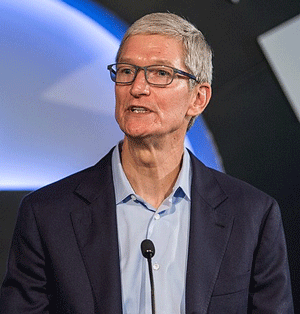Adventures in self-disruption
Apple is preparing to cannibalize its most profitable product, the iPhone. It’s a pattern we’ve seen before. Remember the Newton?
By Brad Berens
This week in The New York Times, we learned about uncharacteristic debate in the executive ranks at Apple around the long-awaited Augmented Reality (AR) glasses that the company will release in June. Some execs worry that there is no market for these glasses, that the price point is too high at $3,000, that there aren’t enough uses for it, and that they’ll gather dust like Meta’s Oculus Rift Virtual Reality (VR) headsets.
Apple CEO Tim Cook, however, is all in on AR: “you’ll wonder how you lived your life without augmented reality, just like today you wonder: How did people like me grow up without the internet?”
Cook is right and the skeptics are wrong. What’s going on is that the skeptics are confusing temporary market realities (have you noticed the economy is a little shaky?) and technical challenges (mapping meat space and digital space onto each other is hard; our current battery technology is Flintstonian) with inevitable technology and behavior trends.
The lack of massive uptake on VR is not a bellwether for AR: that’s the wrong comparison. VR anemia is more like the brief vogue for 3DTV that was all the rage at CES a decade ago and then faded. 3DTV isn’t different enough from 2DTV for most folks to bother upgrading, and the work you have to do to enjoy 3DTV (wear glasses, sit in a particular place) is a drag. Likewise, VR can be amazing, but you need have space to move around blindfolded and not be paranoid that some halfwit family member is going to play a practical joke on you while you are, in essence, wearing a paper bag over your head with an inviting target on your back.
AR is different: it’s not just another world (VR), it’s also a smart window into the real world.
Having a wearable display will transform how you interact with information in both the real world and the digital world. Today, for most people the primary computing device is the smartphone: it’s the thing we have with us all the time, touch hundreds of times per day, and use as a communications, productivity, and entertainment appliance… all in the palms of our hands. Today’s internet is visual first, tactile second, and auditory third.
Tomorrow, AR glasses will replace the smart phone, acting as the hub of a Personal Area Network (PAN) with the screen, microphone, and speakers sitting on your face, a CPU on your wrist or in your pocket or purse, and some kind of unfoldable input device that combines keyboard and mouse. If you have a smartphone, smartwatch, and wireless earbuds, then you already have a primitive PAN. Tomorrow’s internet will be visual first, auditory second, and tactile third: we’ll chit-chat with our Digital Assistants instead of tapping on pieces of glass.
I’ve been thinking about PANs for years and explored them in detail in Redcrosse, my near-future dystopian science fiction novel set in, gulp, April of 2023! I wrote a retrospective of what I got right and what I got wrong a few months back.
For most people, AR glasses won’t just replace the smartphone: it will also replace the laptop, desktop, tablet, and the big screen on the living room wall. Is it any wonder that Cook is chasing AR? These smartglasses will supplant Apple’s entire hardware line.
Rhyming history and Apple’s self-disruption
Cook is playing a long game; it’s a game that Apple has played before. In 1993, Apple released The Newton, the company’s first portable handheld computer, which failed. The company discontinued it in 1998, a year after the smaller, cheaper, and easier-to-use PalmPilot debuted.
The iPhone, the most successful consumer electronics device in history, wouldn’t exist without the Newton. The iPhone debuted in 2007, 14 years after the Newton and just six years after the iPod in 2001. The Newton proved that miniaturizing a computer was possible, and the iPod showed that people would buy a new device if it did something useful—like putting 1,000 songs in your pocket.
When Apple released the iPhone, the iPod was the most successful portable music player on the planet and one of the most successful devices in history. It is astounding that Apple had the corporate sphincter control to disrupt its most successful product, the iPod, making everything the iPod did a feature of the new iPhone. Other companies would have played defense, protecting today’s market and dithering on tomorrow’s like Kodak did with digital photography. These other companies would worry about cannibalization.
Cook’s mentor, Steve Jobs, didn’t. Here’s an illuminating passage from Walter Isaacson’s biography, Steve Jobs:
One of Jobs’s business rules was never to be afraid of cannibalizing yourself. “If you don’t cannibalize yourself, someone else will,” he said. So even though an iPhone might cannibalize sales of an iPod, or an iPad might cannibalize sales of a laptop, that did not deter him. (408)
A similar pattern to “Newton, iPod, iPhone” is happening now. The smartglasses Apple releases this summer are the equivalent of the Newton. It may be a decade or more until Apple figures out and releases the huge hit (iPhone equivalent) version of AR glasses, and there may be intermediary (iPod-like) devices along the way.
With a $2.6 trillion market cap, Apple can afford to take its time.
_________

Brad Berens is the Center’s strategic advisor and a senior research fellow. He is principal at Big Digital Idea Consulting. You can learn more about Brad at www.bradberens.com, follow him on Post and/or LinkedIn, and subscribe to his weekly newsletter (only some of his columns are syndicated here).
See all columns from the Center.
April 5, 2023


